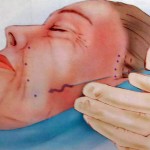
In a recent article in Dermatologic Surgery, they report on their limited experience with barbed sutures for facial lifting. With patients that had an average age of 58 years and whom were followed for 6 to 16 months, six to eight threads per side were placed. Patients judged their own cosmetic results on a scale of 1 to 10. In an effort to provide some objectivity, the amount of cosmetic improvement was also rated by a panel of independent physicians on a scale of 1 to 10 looking at seven of the patients. Patients rated themselves with an average score of 6.6. Independent ratings had an average score of 4.6. The final results were obtained at the 4th postoperative month. Optimal results were judged to last for up to 3 months thereafter.
What do these results tell us? While this study was very small (only 12 patients), there is some critical information in it that does translate to what is already ‘known’ about barbed suture facial lifting. First and foremost, it is really not a procedure for an ‘older’ patient. The results of this clinical study had mediocre clinical results because of the age of the patients. Better results would have been obtained in younger patients in the 40s range. Suture suspension face lifting, in my opinion, is more suited to those patients with minimal facial sagging problems. Preferably those who want to do something but are not ready for an operation of any consequence. In essence, it may be a procedure that helps bridge the time until the patient’s problem worsens and they are ready for a more invasive procedure that provides much more significant changes. Ideally, it will help the patient delay that time a little longer.
Secondly, one can see that the long-term results from suture suspension is not great. Getting a year’s result or so is probably the most one can expect. Again, in a younger patient, the result will likely last somewhat longer. The simple concept is that lifting and cutting (more invasive) is always going to get a better result than lifting and bunching. (minimally invasive) The more scar that is created underneath the skin, the more the result will stay. Or to put it another way, cutting skin out (facelift) is always going to last longer than simply bunching it up elsewhere.
Lastly, patients almost always see cosmetic results better (or worse) than an objective analysis may show. The emotional element of a patient assessing a cosmetic result is huge. One can never underestimate how a small change can make some patients feel better. And, after all, the patient is the final judge and jury of their own outcomes in cosmetic surgery.
Dr. Barry Eppley
Indianapolis, Indiana


